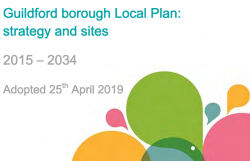 Abraham Lincoln
If given the truth, the people can be depended upon to meet any national crisis...
Abraham Lincoln
If given the truth, the people can be depended upon to meet any national crisis...
 Guildford news...
for Guildford people, brought to you by Guildford reporters - Guildford's own news service
Guildford news...
for Guildford people, brought to you by Guildford reporters - Guildford's own news service
Opinion: Sitting Tight On the Local Plan Is Still the Safest Option – For Now
Published on: 31 Oct, 2022
Updated on: 2 Nov, 2022
Lib Dem borough councillor for Burpham
Neils Laub, in his opinion piece North Hertfordshire Planning Decision Has Implications for Guildford astutely points out the planning inspector’s report for North Herts and the exciting precedent that this sets.
However, whilst this might appear to be good news for Guildford, the reality is potentially somewhat more subdued.
The first thing to note is that any reduction in the housing target does not automatically mean that sites can be returned to the green belt. The relevant planning law states that “exceptional circumstances” are required to alter the boundaries of the green belt. That test applies regardless of whether you are expanding or reducing the green belt, and this test was referenced by the North Herts planning inspector.
So it is not enough for Guildford Borough Council to say “we don’t need all these houses anymore, so we want to return this land to the green belt”. Instead, the council needs to convince a planning inspector that exceptional circumstances exist to justify adding new land to the green belt.
The fact that the “new” land previously was green belt is, unfortunately, irrelevant as far as planning law is concerned. This means, that in practice, even if we get a reduction in the housing target, it may still not be possible to re-designate land as green belt.
Second, Guildford’s Local Plan makes use of the 2016-based figures for assessing housing need. These figures are much higher than the 2018-based figures but significantly lower than the 2014-based figures. When the Local Plan was finalised it was in a very, very brief window in which the government allowed councils to use the lower 2016-based figures.
However by the time the Local Plan was formally adopted the government had already moved the goalposts to insist that councils should return to using the 2014-based figures, because the artificially inflated 2014 figures made it easier for the Conservatives to claim they were on track to hit national housing targets. Guildford was able to slip through using the 2016-based figures, but other councils are still having to use the 2014-based figures.
So the problem for Guildford has been that, while we all know that the 2018-based figures are more accurate and significantly lower, the government has still, to date, insisted that the only acceptable figures to use are the 2014-based figures. (The government’s rules for calculating housing need can be read here.)
 And this is the very good reason why Guildford has not yet re-opened the Local Plan.
And this is the very good reason why Guildford has not yet re-opened the Local Plan.
As long as the government insists that the 2014-based figures must be used, any council which dares to do otherwise will face being, and I quote, “scrutinised more closely at examination”.
What does that mean? It means that if Guildford re-opens the Local Plan and says it wants to use the 2018-based figures instead, then the planning inspector might disagree and impose the current government rule of using the 2014-based figures.
Since the 2014-based figures mean more housing than the 2016-based figures used by the Local Plan, this means that any re-opening of the Local Plan carries a risk of resulting in higher, not lower, housing targets.
So GBC has, in accordance with independent, external legal advice, taken the stance of waiting for the precedents to be set by the planning inspectorate.
The North Herts decision sets a really good precedent. Here you had a council which was otherwise faced with having to use the 2014-based figures, and so it had nothing to lose, meaning there was no risk in trying to persuade the examiner to accept the use of 2018-based figures. And, in this case, the examiner agreed with the council.
 That’s fantastic. It’s an excellent precedent that using the 2018-based figures can be acceptable.
That’s fantastic. It’s an excellent precedent that using the 2018-based figures can be acceptable.
But “one swallow does not a summer make”, and a single precedent does not by itself signal a watershed moment; especially in a case like this where the precedent is for a council faced with otherwise having to use the 2014-based figures, rather than for a council like Guildford which is using the 2016-based figures.
Unfortunately, until more precedents are created there will still be no guarantee of a reduction in the housing target and it is still unwise to rush ahead with re-opening the Local Plan; doing so will still carry the risk of facing an unfriendly inspector and having the higher 2014-based figures imposed.
Once more precedents are established and it becomes clear that the 2018-based figures can be used, or the government finally changes its official methodology, it will then make sense to re-open the Local Plan. Until then the wisest course of action is to sit tight.
And that’s precisely what GBC is doing.
I note that David Roberts, in his own letter to The Guildford Dragon, (Where Do the Lib Dems Stand on the Local Plan?) has had, as he so often does, a pop at the Liberal Democrats with the usual, unfounded, and fact-free, accusation that by being realists we are somehow pro-development at any cost.
The Lib Dem position on the Local Plan is as it has always been. Within the constraints imposed on us by central government, we want to do the best we can for all residents of the borough.
That means strengthening planning policies to ensure that any new development is as sustainable, as high quality and as supported by the necessary infrastructure as possible. It means ensuring that developments contain affordable housing and it means ensuring that development does not come at the expense of wildlife and biodiversity.
But it also means acknowledging that Guildford borough is grotesquely unaffordable to live in, that the needs of our young people and new families to be able to afford homes to live in is more important than some people’s dislike of change, and that the responsibility of local politicians is to attempt to find an equitable balance between competing interests and viewpoints on development when disagreements inevitably arise.
Or, to put it another way, the Liberal Democrat stance is responsible decision-making, guided first and foremost by the desire to do the greatest possible good for the greatest possible number of people within our borough, and not just for those who want no or very little development.
One final point, quite often I see people suggesting that the Liberal Democrats are somehow blocking R4GV from doing what they want to do on the Local Plan. That is completely untrue. There is no substantive disagreement between the coalition parties on the Local Plan, and R4GV’s party leader holds the Planning Policy portfolio.
So if Mr Roberts is looking for an explanation of R4GV’s actions on the Local Plan then I can only advise him to ask them the question directly.
Responses to Opinion: Sitting Tight On the Local Plan Is Still the Safest Option – For Now
Leave a Comment Cancel replyPlease see our comments policy. All comments are moderated and may take time to appear.
Recent Articles
- Guildford Institute’s Crowdfunding Project for Accessible Toilet in its New Community and Wellbeing Centre
- Letter: Guildford – Another Opportunity Missed?
- Letter: GBC’s Corporate Strategy – Where Is the Ambition?
- My Memories of John Mayall at a Ground-breaking Gig in Guildford Nearly Six Decades Ago
- Westborough HMO Plans ‘Losing the Heart of the Street’ Says Resident
- College Invests to Boost Surrey’s Economy and Close Digital Skills Gap
- Community Lottery Brings Big Wins for Local Charities
- GBC Housing Plan Promises ‘A Vibrant Urban Neighbourhood’ Near Town Centre
- Hospital Pillows ‘Shortage’ at the Royal Surrey
- Updated: Caravans Set Up Camp at Ash Manor School


Recent Comments
- Ian Macpherson on Updated: Main Guildford to Godalming Road Closed Until August 1
- Sara Tokunaga on GBC Housing Plan Promises ‘A Vibrant Urban Neighbourhood’ Near Town Centre
- Michael Courtnage on Daily Mail Online Reports Guildford Has Highest-paid Council Officer
- Alan Judge on GBC Housing Plan Promises ‘A Vibrant Urban Neighbourhood’ Near Town Centre
- John Perkins on GBC Housing Plan Promises ‘A Vibrant Urban Neighbourhood’ Near Town Centre
- S Collins on GBC Housing Plan Promises ‘A Vibrant Urban Neighbourhood’ Near Town Centre
Search in Site
Media Gallery
Dragon Interview: Local Artist Leaves Her Mark At One of England’s Most Historic Buildings
January 21, 2023 / No Comment / Read MoreDragon Interview: Lib Dem Planning Chair: ‘Current Policy Doesn’t Work for Local People’
January 19, 2023 / No Comment / Read MoreA3 Tunnel in Guildford ‘Necessary’ for New Homes, Says Guildford’s MP
January 10, 2023 / No Comment / Read More‘Madness’ for London Road Scheme to Go Ahead Against ‘Huge Opposition’, Says SCC Leader
January 6, 2023 / No Comment / Read MoreCouncillor’s Son Starts Campaign for More Consultation on North Street Plan
December 30, 2022 / No Comment / Read MoreCounty Council Climbs Down Over London Road Works – Further ‘Engagement’ Period Announced
December 14, 2022 / No Comment / Read MoreDragon Interview: GBC Reaction to the Government’s Expected Decision to Relax Housing Targets
December 7, 2022 / No Comment / Read MoreHow Can Our Town Centre Businesses Recover? Watch the Shop Front Debate
May 18, 2020 / No Comment / Read More











Jim Allen
October 31, 2022 at 4:24 pm
“Sustainable homes” means homes with water, foul water disposal and energy supply. What is the point of arguing housing numbers when there are no jobs in the area (we ostensibly have full employment) and a falling birth rate.
The arguments should be about water supply, electrical generation, road capacity and sewage capacity.
This single-subject argument on housing numbers is getting tired and worn out.
Ben Paton
October 31, 2022 at 9:36 pm
This opinion piece is short of facts. Mr Laub supported his arguments with ONS figures and legal precedents. Where is the evidence to support Mr Potter’s opinion?
The legal advice? Just one single barrister’s opinion. Has anyone seen his instructions? Or his/her written opinion? What was the analysis?
The government’s opinion on the appropriate ONS figures to use? Is there any correspondence between GBC and the government to support Cllr Potter’s statements? Or is it all supposition?
R4GV’s opinion? When I asked a leading R4GV Councillor he emphatically stated that R4GV could not do anything without the Lib Dems and the Lib Dems were determined to leave the Local Plan in place.
Green belt? To take sites out of the Local Plan it is not necessary to put them back into the green belt. These are separate issues. To confabulate them is obfuscation.
Responsibility? The then Lib Dem leader voted for this Local Plan. The Lib Dems supported the development of the disastrous Local Plan for a decade.
To adjust the Local Plan the Lib Dems now demand guarantees. Pity they were not risk-averse before they put it in place with the Guildford Conservatives.
This is Lib Dem dissimulation.
Jules Cranwell
November 1, 2022 at 6:11 am
What absolute nonsense. There were absolutely no grounds to rob our villages, as “exceptional circumstances” did not exist. Now there are clearly exceptional circumstances to reinstate the green belt, as the inflated housing figures used for the Local Plan have been shown to be massively flawed.
Perhaps Cllr Potter would care to leave downtown Guildford, and come to the Horsleys and tell residents that nothing should be done.
Niels Laub
November 1, 2022 at 8:34 am
In view of the fact that the amount of land set aside for development in the adopted Local Plan will generate 14602 dwellings whereas the housing requirement is only 10,678, can Cllr Potter explain the “exceptional circumstances” which necessitated the release of 1,474 hectares of the green belt for development?
One thing that is perfectly clear from Mr Potter’s article is that the Lib Dems clearly have no appetite for reviewing the housing targets in the adopted Local Plan nor would they be prepared to reinstate any land removed from the green belt even if the housing target were to be reduced.
Some of us, particularly in the Burpham Ward, may wish to bear this in mind at the next local elections.
Currently, there is a requirement for Local Planning Authorities to use the “Standard Method” to calculate their housing need. If we were to recalculate the housing need to Guildford using the Standard Method but applying the latest most current household projections, the housing need would be reduced to 162 dwellings per annum, not 562 as per the Local Plan – that is 400 per annum less.
David Roberts
November 1, 2022 at 11:00 am
As a longstanding defender of the Tories’ flagship local policy, Cllr Potter appears to be in the wrong party. Perhaps he should defect, like Cllr Harwood who holds identical views on the Local Plan. But Lib Dem councillors are famously unwhipped and disunited, and I cannot believe its leaders can afford this policy of “Do Nothing”. Will this seriously be their rallying cry in next May’s local elections?
We deserve to hear from the silent Lib Dem (and current council) leader Cllr McShane whether Potter policy is really Lib Dem policy, as well as from Lib Dem councillors representing rural wards where the Local Plan is doing so much harm.
We should not be spooked by the Haloween scare-story that a review of the Local Plan would produce a higher housing target, rather than the much lower one as set out by Mr Laub. This is a far-fetched hypothesis, as Cllr Potter’s convoluted argument shows. No inspector would ignore new legal precedent or more than eight years of recent ONS population data including the national census. The imagined risk is vanishingly small and well worth running.
To me the issue is straightforward. Guildford’s Local Plan needs fixing. The party that commits to fixing it gets my vote.